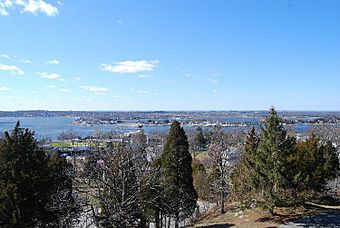Fort Barton Site facts for kids
Quick facts for kids |
|
|
Fort Barton Site
|
|
 |
|
| Location | Lawton and Highland Aves. Tiverton, Rhode Island |
|---|---|
| NRHP reference No. | 73000056 |
| Added to NRHP | March 7, 1973 |
The Fort Barton Site is a historic place in Tiverton, Rhode Island. It was once an important fort during the American Revolutionary War. Today, it's a public park where you can explore what remains of the old fort.
Contents
What is Fort Barton?
Fort Barton was built during the American Revolutionary War. It was a defensive post, meaning it was a place to protect against attacks. The fort was strategically placed to watch over a main ferry crossing. This ferry connected Tiverton to Aquidneck Island. At that time, Aquidneck Island was controlled by the British.
What Remains of the Fort?
Today, you won't see tall walls or buildings at Fort Barton. What's left are its "earthworks." These are like big dirt mounds and ditches. They form a shape that's about 150 feet (46 meters) long and 100 feet (30 meters) deep. These earthworks were the fort's main defenses.
Fort Barton's Role in the Revolution
The fort was built in 1777. Its location was very important for the American forces. The ferry crossing it overlooked was a key route.
The Battle of Rhode Island
In August 1778, the ferry near Fort Barton became a launching point. American soldiers used it to start their attack during the Battle of Rhode Island. This was a major battle in the Revolutionary War. The fort helped protect the American forces as they prepared.
Who Was William Barton?
The fort is named after Lieutenant Colonel William Barton. He was an American soldier who became famous for a daring act. In 1777, he led a secret "midnight raid." During this raid, he successfully captured a British general named General Prescott. General Prescott was at his headquarters at Prescott Farm in what is now Portsmouth. This capture was a big win for the Americans.
Fort Barton Today
The Fort Barton Site is recognized for its historical importance. It was added to the National Register of Historic Places in 1973. This means it's a special place that is protected because of its history. You can visit the park today to learn about this part of American history.

